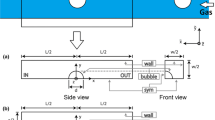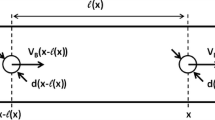Abstract
The motion of a liquid inclusion inside a 1D microchannel filled with gas and externally heated is simulated. An incompressible formulation is used for the liquid, while a low Mach approximation is considered for the gas flow. Gas–liquid interfaces are captured using an Arbitrary Lagrangian Eulerian method. The whole liquid–gas system is shown to behave as a damped oscillator. Natural frequency of the linearized system and associated eigenmodes are first identified. Forced oscillations are investigated for different heating conditions (temperature or heat flux) at the microchannel ends. Detailed analyses are performed which reveal the main thermo-mechanical effects involved in the oscillations. The relevant parameters governing the dynamics are found out through a dimensionless analysis. Finally, heating conditions leading to non decaying oscillations of the liquid inclusion are proposed.



















Similar content being viewed by others
References
Canuto C, Hussaini M, Quarteroni A, Zang T (1990) Spectral methods in fluids dynamics. In: Springer series in computational physics. Springer, Heidelberg
Chenoweth D, Paolucci S (1986) Natural convection in an enclosed vertical air layer with large horizontal temperature differences. J Fluid Mech 169:173–210
Colin S (2005) Rarefaction and compressibility effects on steady and transient gas flows in microchannels. Microfluid Nanofluid 1:268–279
Cooney C, Towe B (2004) A thermopneumatic dispensing pump. Sens Actuators A 116:519–524
Cristini V, Tan Y (2004) Theory and numerical simulation of droplets dynamics in complex flows—a review. Lab Chip 4:257–264
Daru V, Duluc MC, Le Maître O, Juric D, Le Quéré P (2006) Modélisation et simulation numérique du changement de phase liquide-vapeur en cavité. CRAS Mécanique 224:25–33
Erickson D (2005) Towards numerical prototyping of labs-on-chip: modeling for integrated microfluidic devices. Microfluid Nanofluid 1:301–318
Jiao Z, Nguyen NT, Huang X, Ang Y (2007) Reciprocating thermocapillary plug motion in an externally heated capillary. Microfluid Nanofluid 3:39–46
Li Z, Ito K (2006) The immersed interface method. In: Frontiers in applied mathematics. SIAM, Philadelphia
Liu M, Liu G (2005) Meshfree particle simulation of micro channel flows with surface tension. Comput Mech 35:332–341
Liu M, Meakin P, Huang H (2007) Dissipative particle dynamics simulation of multiphase fluid flow in microchannels and microchannel network. Phys Fluids 19(3):033302
Majda A, Sethian J (1985) The derivation and numerical solution of the equations for zero Mach number combustion. Combust Sci Technol 42:185–205
Medale M, Jaeger M (1997) Numerical simulations of incompressible flows with moving interfaces. Int J Numer Methods Fluids 24:615–638
Mukherjee A, Kandlikar S (2005) Numerical simulation of growth of a vapor bubble during flow boiling of water in a microchannel. Microfluid Nanofluid 1:137–145
Navti S, Ravindran K, Taylor C, Lewis R (1997) Finite element modelling of surface tension effects using a Lagrangian–Eulerian kinematic description. Comput Methods Appl Mech Eng 147:41–60
Osher S, Fedkiw R (2003) Level set methods and dynamic implicit surface. In: Applied mathematical sciences, vol 153. Springer, Heidelberg
Pozrikidis C (1992) Boundary integral and singularity methods for linearized viscous flow. Cambridge University Press, London
Scardovelli R, Zaleski S (1999) Direct numerical simulation of free-surface and interfacial flow. Ann Rev Fluid Mech 31:567–603
Selva B, Français O, Rousseau L, Poulichet P, Desportes S., Delaire J, Grenier D, Jullien MC (2007) Thermal actuation in a cross-channel micromixer. In: MicroTAS
Tryggvason G, Bunner B, Esmaeeli A, Juric D, Al-Rawahi N, Tauber W, Han J, Nas S, Jan Y (2001) A front-tracking method for the computations of multiphase flow. J Comput Phys 169(2):708–759
Worlibar A, Knio O (1996) Numerical simulation of a thermoacoustic refrigerator: I Unsteady adiabatic flow around the stack. J Comput Phys 127:424–451
Yang Z, Palm B, Sehgal B (2002) Numerical simulation of bubbly two-phase flow in a narrow channel. Int J Heat Mass Transf 45:631–639
Zheng H, Shu C, Chew Y (2006) A lattice boltzmann model for multiphase flows with large density ratio. J Comput Phys 218:353–371
Author information
Authors and Affiliations
Corresponding author
Appendix: Numerical methods
Appendix: Numerical methods
The domains Ωi moving with time, an Arbitrary Lagrangian Eulerian (ALE) method (see, e.g., Navti et al. 1997; Medale and Jaeger 1997) is used for the resolution of the governing equations of the flow. Specifically, linear transformations are used to map \(\Upomega^1\cup\Upomega^{\rm l}\cup\Upomega^2\) to a reference mathematical domain \([0, 1] \cup [1, 2]\cup[2,3]\). The spatial discretization uses a high-order spectral element for each sub-domain, with order p for the temperature, density, velocity and order p − 2 for the hydrodynamic pressure (Canuto et al. 1990). The mapping being time dependent, it yields additional correction terms in the governing equations to account for the mesh velocity. The time integration of the flow involves diverse time discretizations and numerical methods for the inversion of the resulting discrete operators. The complete numerical methodology is detailed elsewhere, and we simply provide here a quick overview of the structure of a time step. For simplicity, we temporarily drop the domain indexes that instead will denote the time level. We assumed the solution known at time level nΔt, where Δt is the time-step of the simulation. The whole procedure for the determination of the solution at t = (n + 1)Δt is
-
1.
Set guessed estimates P n+1 for the thermodynamic pressure at the end of the time step.
-
2.
Using P n+1, update velocities and positions of the interface using a semi-implicit Newmark time-scheme. It yields the ALE mapping (geometry and mesh velocities).
-
3.
Prediction step
-
The energy equations in the sub-domains are solved for a provisional temperature field T*, using an implicit time-scheme and Schwartz methods for the enforcement of continuity conditions across the interfaces. Other variables are taken to their respective values at t = nΔt.
-
Provisional thermodynamical pressures P* and density fields ρ* in the two gas domains are then determined using equation (8) and the state equation, respectively.
-
Momentum equations in the gaseous domains are then solved for the provisional velocities u* and hydrodynamic pressures Π*. The latter is determined, through the resolution of an elliptic problem, as to yield \(\frac{\partial}{\partial x}(\rho u)*\) consistent with an estimate of \(\frac{\partial}{\partial t} \rho\) based on ρn and ρ*.
-
-
4.
Correction step
-
Solve the energy equation for T n+1 as in the prediction step, but using the provisional values for the other variables.
-
Set thermodynamical pressures P n+1 and density fields ρn+1 in the two gas domains.
-
Set the velocities u n+1 and hydrodynamic pressures Πn+1. The latter now being determined to yield \(\frac{\partial}{\partial x}(\rho u)^{n+1}\) consistent with an estimate of \(\frac{\partial} {\partial t} \rho\) based on ρn and ρn+1.
-
-
5.
If the computed thermodynamical pressures P n+1 are different from the ones used at step 1, restart from step 2 for a new iteration.
In the computation presented in this study, three to four iterations were needed for the convergence of the thermodynamical pressure P n+1.
Rights and permissions
About this article
Cite this article
Duluc, MC., Le Maître, O.P., Daru, V. et al. Numerical study of liquid inclusion oscillations inside a closed 1D microchannel filled with gas. Microfluid Nanofluid 6, 163–177 (2009). https://doi.org/10.1007/s10404-008-0308-2
Received:
Accepted:
Published:
Issue Date:
DOI: https://doi.org/10.1007/s10404-008-0308-2




